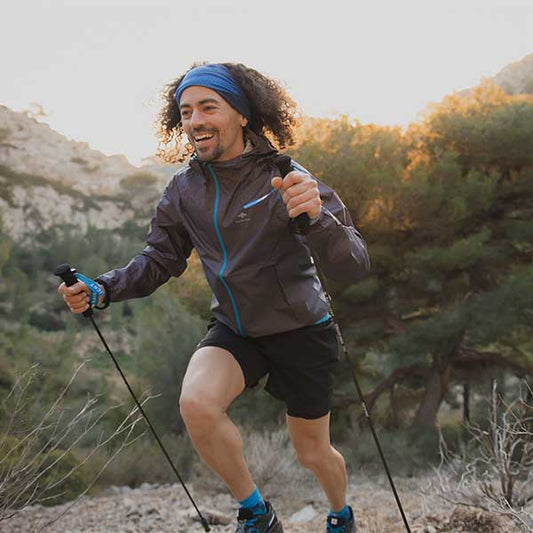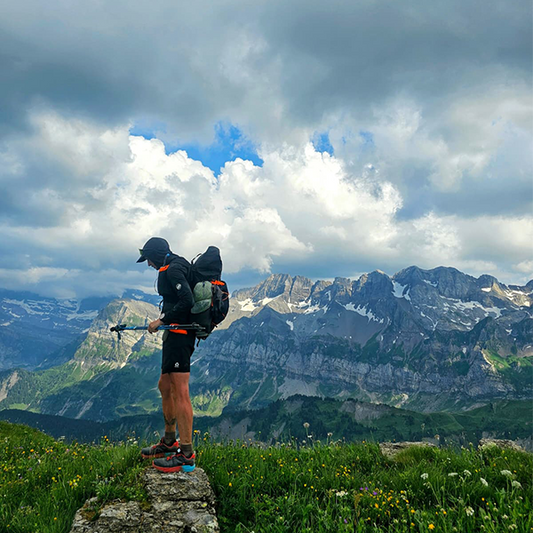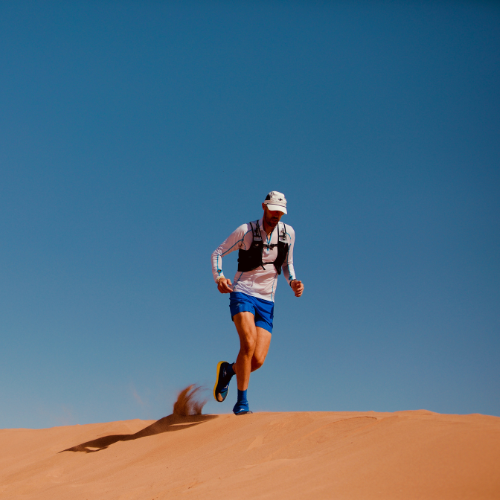Preparing for a desert race, particularly for legendary events such as the Marathon des Sables® or the Oman Desert Marathon®, requires much more than just endurance. Indeed, the sandy terrain, extreme temperatures and length of the stages impose unprecedented race conditions, requiring adapted physical preparation. Whether you're a novice or an experienced runner, appropriate physical preparation, combining targeted training and muscle strengthening, is essential if you are to rise to the challenge and succeed in this extraordinary adventure.
To provide you with the best possible support, we've called on Matthieu Andreux, our ambassador and coach specializing in physical preparation for trail athletes. For years, he has been helping runners, both amateur and experienced, to optimize their performance and prevent injuries. A graduate in physical preparation, nutrition and reathletization, Matthieu is renowned for his scientific and individualized approach. His aim? To help each individual realize their full potential while maintaining good physical health.
Find Matthieu on Instagram under the name matthieu_training and on https://calendly.com/matthieu-andreux/prise-de-rendez-vous-challenger

1. Muscular strengthening: the basis of effective preparation
Sandy terrain is unstable and requires greater use of the stabilizing muscles and lower limbs. Sand absorbs part of the thrust, making each stride more energy-intensive.
Key muscles to strengthen :
- Ankles and calves:
- Ankles to prevent increased fatigue on unstable terrain.
- The calves, which are stressed with every drive, need to be strengthened to limit fatigue.
- Quadriceps and glutes :
- These muscles are particularly involved when climbing up dunes and relaunching on soft sand.
- Core training:
- A strong core ensures better posture, which is essential over long distances where fatigue impairs technique.
Recommended exercises :
- Ankle reinforcement: https://www.youtube.com/watch?v=v3_z078LLV8
- Bench climbs with load : Simulates uphill effort and strengthens quadriceps and glutes.
- Buttock bridges and dynamic sheathing: Strengthens core and stabilizing muscles.
- Plyometric jumps on sand : Develop muscular power while getting the body used to instability.
Practical tip : Incorporate specific sessions on sand once a week to accustom the muscles to the particular exertion of this terrain.
2. Developing strength endurance for long stages
Running in the desert requires you to repeat a prolonged effort over several days, often with a backpack. This repetition demands not only the cardiovascular system, but also muscle endurance.
Objective: delay muscle fatigue
- Functional strengthening : Combine complex movements with moderate loads, e.g. circuits combining squats, lunges and dynamic gainage.
- Long-duration training : Include long outings (3 to 6 hours) with a progressive weight pack, to accustom muscles to the load and prolonged effort.
- Repeated ascents: On gentle slopes or sand, alternate phases of sustained effort and active recovery.
Example of a specific session:
- Warm-up (20 min): Slow run over varied terrain.
- Specific work (30-40 min) :
- Climbs on sand or gentle slope, 3 min effort, 1 min recovery.
- 6 to 8 repetitions.
- Muscle strengthening (20 min): Squats, lunges, dynamic sheathing.
- Relaxation (10 min): Stretching and mobility.
3. Training for effort management in the heat
Extreme heat increases heart rate, accelerates dehydration and reduces muscular performance. Training must include progressive adaptation to prepare the body for these conditions.
Acclimatization strategies :
- Simulated heat training :
- Running in hot conditions or using clothing that increases body temperature.
- Example: a treadmill session in a heated room or after a sauna session.
- Progression of duration :
- Start with short warm-up sessions (30-45 min), then gradually build up to 90 min.
- Hydration in real-life conditions :
- Get used to drinking regularly (150-250 ml every 15-20 min) and test the isotonic or electrolyte drinks that will be used during the race.
4. Strengthen stride and energy efficiency
In the desert, every step costs more energy. Optimizing running economy preserves your strength over the long stages.
It's important to know how to change pace: know how to clearly SLOW DOWN during sandy phases (switch to “4x4” mode and grind...), then resume a racing pace afterwards.
Training in the snow is an excellent simulation of effort in the sand.
Improving race economy:
- Stride technique :
- Work on a low, economical stride, with short strides to minimize effort on the sand.
- Exercise: perform cadence sessions, aiming for 180 steps/min to improve efficiency.
- Snow sessions whenever possible
- Recovery work :
- Incorporate short sand sprints (10-15 sec) to develop explosiveness and the ability to restart after a slow phase.
- Eccentric reinforcement :
- Dune descents place intense demands on the quadriceps. Exercises such as eccentric squats (slow descent, fast ascent) strengthen these muscles and reduce the risk of injury.
5. Planning: integrating specific blocks
A training plan for a desert race should be progressive and include specific blocks to simulate real conditions.
Example of a 12-week plan:
- Weeks 1 to 4: Basic
- General work: muscle strengthening, fundamental endurance, moderate long runs.
- 1 proprioception session/week.
- Weeks 5 to 8: Specific
- Introduction of sessions on sand or unstable ground.
- Progressive increase in load (bag) and duration (long outings up to 4-5 h).
- Heat acclimatization sessions.
- Weeks 9 to 12: Pre-competition
- Intensive blocks simulating the stages of a race: two days of long outings with a bag.
- Gradually reduce volume to arrive fresh on the big day.
Physical preparation for desert races such as the Marathon des Sables® or the Oman Desert Marathon® or the Raidlight Desert Trophy requires targeted muscle strengthening, robust strength endurance and progressive adaptation to extreme desert conditions. A structured and specific training program enables each runner to overcome the unique challenges of the desert and transform these obstacles into opportunities for personal achievement.
Matthieu offers you a free 12-week training plan to prepare you for a desert stage race. The aim of this program is to optimize your performance while maximizing your recovery between each stage. You can download it for free by clicking here.
To find out more about Matthieu or learn more about his work, visit his website. https://www.matthieu-training.fr/

Want to find out more about the Raidlight Desert Trophy? Click here for more information
Need some advice for your next desert race? We've dedicated more articles to this topic:
We have also designed a complete guide to accompany you and share with you all our practical advice for your desert race: preparation and organization of your trail bag, food, equipment, training, life on the bivouac... You can download this free guide by clicking here.










